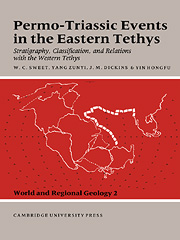 Permo-Triassic Events in the Eastern Tethys
Permo-Triassic Events in the Eastern Tethys Book contents
- Frontmatter
- Contents
- List of contributors
- Preface
- Acknowledgments
- 1 Permo-Triassic events in the eastern Tethys – an overview
- 2 Permo-Triassic boundary relations in South China
- 3 Permo-Triassic boundary of the Indian subcontinent and its intercontinental correlation
- 4 Permo-Triassic boundary on the Indian peninsula
- 5 The Permo-Triassic boundary in the southern and eastern USSR and its international correlation
- 6 Classification and correlation of nonmarine Permo-Triassic boundary in China
- 7 Permian and Triassic events in the continental domains of Mediterranean Europe
- 8 The Permo-Triassic boundary in the Southern Alps (Italy) and in adjacent Periadratic regions
- 9 Permo-Triassic brachiopod successions and events in South China
- 10 Conodont sequences in the Upper Permian and Lower Triassic of South China and the nature of conodont faunal changes at the systemic boundary
- 11 A conodont-based high-resolution biostratigraphy for the Permo-Triassic boundary interval
- 12 The palynofloral succession and palynological events in the Permo-Triassic boundary interval in Israel
- 13 The effects of volcanism on the Permo-Triassic mass extinction in South China
- 14 Geochemical constraints on the Permo-Triassic boundary event in South China
- 15 Permo-Triassic orogenic, paleoclimatic, and eustatic events and their implications for biotic alteration
- 16 Permo-Triassic boundary in Australia and New Zealand
- Index
12 - The palynofloral succession and palynological events in the Permo-Triassic boundary interval in Israel
Published online by Cambridge University Press: 12 October 2009
- Frontmatter
- Contents
- List of contributors
- Preface
- Acknowledgments
- 1 Permo-Triassic events in the eastern Tethys – an overview
- 2 Permo-Triassic boundary relations in South China
- 3 Permo-Triassic boundary of the Indian subcontinent and its intercontinental correlation
- 4 Permo-Triassic boundary on the Indian peninsula
- 5 The Permo-Triassic boundary in the southern and eastern USSR and its international correlation
- 6 Classification and correlation of nonmarine Permo-Triassic boundary in China
- 7 Permian and Triassic events in the continental domains of Mediterranean Europe
- 8 The Permo-Triassic boundary in the Southern Alps (Italy) and in adjacent Periadratic regions
- 9 Permo-Triassic brachiopod successions and events in South China
- 10 Conodont sequences in the Upper Permian and Lower Triassic of South China and the nature of conodont faunal changes at the systemic boundary
- 11 A conodont-based high-resolution biostratigraphy for the Permo-Triassic boundary interval
- 12 The palynofloral succession and palynological events in the Permo-Triassic boundary interval in Israel
- 13 The effects of volcanism on the Permo-Triassic mass extinction in South China
- 14 Geochemical constraints on the Permo-Triassic boundary event in South China
- 15 Permo-Triassic orogenic, paleoclimatic, and eustatic events and their implications for biotic alteration
- 16 Permo-Triassic boundary in Australia and New Zealand
- Index
Summary
Introduction
The stratigraphy and nature of the Permo-Triassic boundary interval in the world have long been debated. Controversies have been fueled by incomplete sections, hiatuses, and by the provinciality of fossils. Although some fossil groups have been used to provide biozonations in the boundary interval, debates have centered on the question of whether these really represent the entire time span, or if there are unrecognized hiatuses. For example, Sokratov (1983) suggested that an additional, previously unrecognized ammonoid zone should be added between the highest Permian and the lowest Triassic biozones in the Caucasus region, where one of the most continuous sequences of boundary-interval strata is believed to occur.
Rock layers that represent the Permo-Triassic boundary interval are not exposed in Israel, and all available information comes from boreholes in the Negev in the southern part of the country (Fig. 12.1). The lithologic column in most boreholes, including the type section (Makhtesh Qatan 2 borehole: Figs 12.1, 12.2), represents what appears to be continuous sedimentation in shallow marine environments across the Permo-Triassic boundary (Weissbrod, 1981). However, in the Pleshet 1, Shezaf 1, and Zohar 8 boreholes, the boundary is within a thin layer of red clay of unknown origin.
In contrast with the apparent continuity in sedimentation, the palynologic assemblages exhibit a marked change within the boundary interval. As a result, assemblages thought to be Upper Permian can easily be distinguished from ones regarded as Lower Triassic. This fact enhances the usefulness of sporomorphs in defining the Permo-Triassic boundary in Israel.
- Type
- Chapter
- Information
- Permo-Triassic Events in the Eastern TethysStratigraphy Classification and Relations with the Western Tethys, pp. 134 - 145Publisher: Cambridge University PressPrint publication year: 1992
- 4
- Cited by


